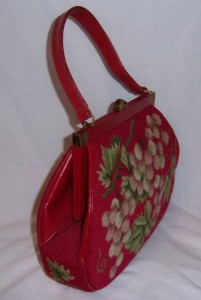
Updated March 20, 2018.
A few years I had an occasion to look at the oldest needlepoint book I own, Needlepoint Made Easy, published in 1955.
It gave me pause, because I was also looking at the first edition of The Needlepoint Book, first published 21 years later.
Since most of us started stitching after the needlepoint “revolution” of the early 70’s we probably don’t think about it much, but the needlepoint of the 50’s was very different. That’s when my grandmother probably tried needlepoint. It was a pre-stitched canvas in a Berlinwork style. The colors were dull. She only had to fill in the background. She was an amazing dressmaker, knitter, and crocheter. She never finished the piece.
In the 50’s almost all needlepoint was pre-worked and very traditional in style. Furnishings inspired by the American colonies was popular and these designs fitted well in those decors.
Wool ruled to the exclusion of almost anything else. Original design was not encouraged, in the 50’s book only a short chapter near the end covers it.
Half-cross was the default stitch. Although Basketweave and Continental are covered, every picture of the back of stitching is half-cross. Only one non-tent stitch is even mentioned, Bargello, and no Bargello pieces are shown, so you can’t do a project in Bargello from this book.
There is more creativity in British books of the time, but not much more. The names we think of: Mary Rhodes, Constance Howard, and even Erica Wilson were all working then, but they did many types of needlework, not just needlepoint.
It’s as if the wonderful creativity of Victorian and early 20th-century needlepoint had gotten watered down to this little piece Grandma bought at a department store. It’s a sad testament to how techniques can be forgotten in only a generation or two.
Then look at The Needlepoint Book. You are encouraged to design your own projects and the author’s original designs are throughout the book. There are many, many stitches, both pictured and diagrammed.
You learn advanced techniques, in the 50’s book the only advanced technique covered is how to repair or splice canvas. You learn about color and design. All this was before the revolution in threads.
Even so, The Needlepoint Book from the 70’s looks contemporary and is still useful. The book from the 50’s looks quaint.
Think how far we have come!
About Janet M Perry
Janet Perry is the Internet's leading authority on needlepoint. She designs, teaches and writes, getting raves from her fans for her innovative techniques, extensive knowledge and generous teaching style. A leading writer of stitch guides, she blogs here and lives on an island in the northeast corner of the SF Bay with her family

This was particularly interesting to me since I marvel at my mom’s needlepoint on a daily basis. She stitched pre-worked (mostly florals) on Penelope canvas, and did them in hand. She started each vertical row at the bottom by weaving the wool through a few holes in the canvas and then she used the sewing method to stitch half-cross stitches straight up the row!
From what I can tell now, this completely defies all proper technique and her pieces should have been warped and a mess, but each and every piece that my sister and I have is absolutely perfect and a wonderful treasure to us!
I often wonder if Mom were here today…what kind of needlepointer would she be? Would she still prefer florals with tent/basketweave/half-cross stitch, or would she be an embellisher extraoidenaire?
That’s exactly what was pictured in the book. I did my needlepoint in hand for years and lots of the machine-made needlepoint you see is half-cross on penelope.
It’s not out of shape.
How did they do it?
On the other hand, recently I came across examples of original early 19th century charts for ‘berlin wool work’ and they used all the different fancy stitches, just as in the ‘modern’ needlepoint books. I think that perhaps the 1950s book represents a low point where needlepoint was unfashionable or printed designs had taken over so completely from charts that alternative stitches were neglected.
From 1920-1950 the world was consumed by World Wars and there were enormous shortages of many goods. Also there were far fewer labor saving devices so the work women did at home was far more extensive. Victorian wool work was the plaything of the emerging bourgeois class due to industrialization
of the late 1800’s and was developed to mimic many of the fine woven pieces in the homes of the really wealth and noble classes. WWII put a strangle hold on supplies and wool was used for uniforms, socks and to keep the home fires warm. There was a recent posting about Queen Mary stitching panels for a rung during WWII that was preset by the royal School of Needlework. It later was sold to Canada to raise dollars to reduce British debt to America. Through that time, patterns were available through the newspaper and women magazines. Just a few patterns at a time. It was not until the 60’s with the emergence of a new generation – the baby boomers who revived personal adornment ( remember all those embroidered jeans we had) in the hippy era and later modern communications – such as Erica Wilson’s TV show- that expanded the awareness of expanded possibilities.
needlework and expanded possibilities. the age of the internet has further expanded access to a huge variety of threads, online classes and more designs.